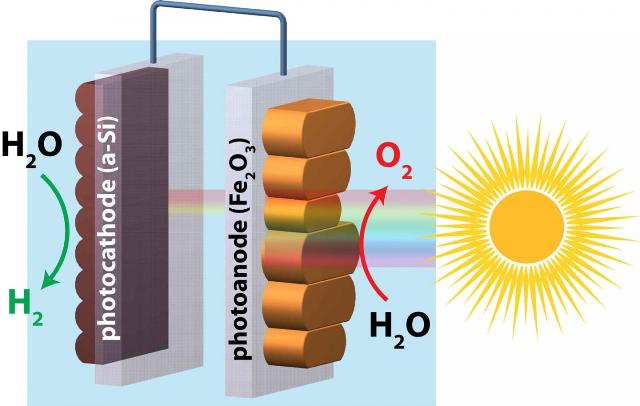Jun 17 2015
The poor performance of the mineral hematite began the quest for the identification of a suitable method for mining electron-rich hydrogen to achieve clean power. Researchers from the Boston College, UC Berkeley and China's University of Science and Technology have developed a smoother form of hematite by 're-growing' the mineral's surface.
The new version was found to increase the electrical yield by twofold, paving way for the energy-harvesting artificial photosynthesis. The research was published in the Nature Communications journal.
 Water splitting combines sunlight and water in a chemical reaction in order to harvest clean hydrogen energy. By smoothing the surface of hematite, a team of researchers led by Boston College chemist Dunwei Wang achieved 'unassisted' water splitting using the abundant rust-like mineral and silicon to capture and store solar energy within hydrogen gas (Credit: Nature Communications)
Water splitting combines sunlight and water in a chemical reaction in order to harvest clean hydrogen energy. By smoothing the surface of hematite, a team of researchers led by Boston College chemist Dunwei Wang achieved 'unassisted' water splitting using the abundant rust-like mineral and silicon to capture and store solar energy within hydrogen gas (Credit: Nature Communications)
According to Boston College associate professor of chemistry Dunwei Wang, a lead author of the report, the new re-grown hematite turned out to be an improved power generating anode, as it produced a record low turn-on voltage enabling the researchers to use earth-abundant hematite and silicon as the light absorbers in artificial photosynthesis for the first time.
The overall efficiency achieved using the new method of harvesting hydrogen was 0.91%, which is an acceptable percentage, yet the first 'meaningful efficiency ever measured by hematite and amorphous silicon, two of the most abundant elements on Earth,' the team reported.
'By simply smoothing the surface characteristics of hematite, this close cousin of rust can be improved to couple with silicon, which is derived from sand, to achieve complete water splitting for solar hydrogen generation. This unassisted water splitting, which is very rare, does not require expensive or scarce resources,' said Wang, whose research focuses on discovering new methods to generate clean energy.
According to Wang, the findings symbolized a critical step towards the realization of the potential performance that theoretical models have determined for an iron oxide, hematite, which is similar to rust.
'This offers new hope that efficient and inexpensive solar fuel production by readily available natural resources is within reach. Getting there will contribute to a sustainable future powered by renewable energy,' said Wang.
The research team focused on the surface imperfections present in hematite, which have been previously studied to minimize the 'turn-on' voltage required for initiating photoelectrochemistry which is the key process involved in artificial photosynthesis for capturing and storing solar power in hydrogen gas.
The hematite surface features were re-evaluated using a synchrotron particle accelerator at the Lawrence Berkeley National Laboratory. The new 're-growth' approach was established by applying an acidic solution to the material in the present of strong heat. This process was observed to simultaneously minimize ridges and filled depressions thereby producing smooth surface.
Test results showed an increase in turn-on voltage and photovoltage from 0.24V to 0.80V, which is an exceptional improvement in power generation.
The team also reported that any further changes in the new hematite-silicon method could make it vulnerable for large-scale use. Additionally, the 're-growth' technique can be applied to other materials under research to achieve further developments in artificial photosynthesis.
'It is a delight to see that a simple re-growth treatment can do so much to improve the performance of hematite. Due to its prior poor performance, hematite has been pronounced 'dead' by many leading researchers in the field. We are happy to show that much can be harvested from this earth abundant, non-toxic material,' said Wang.